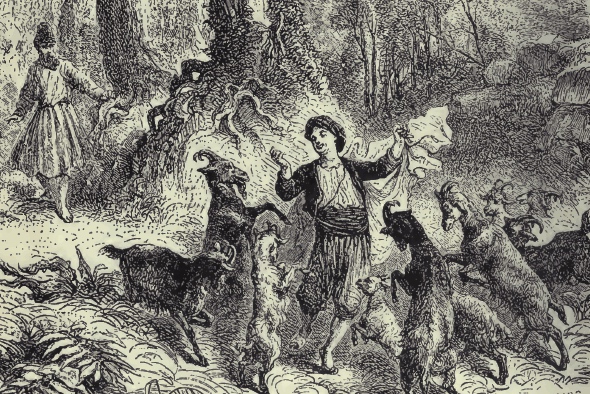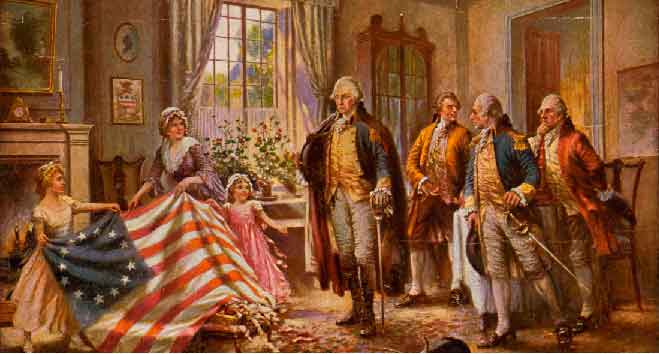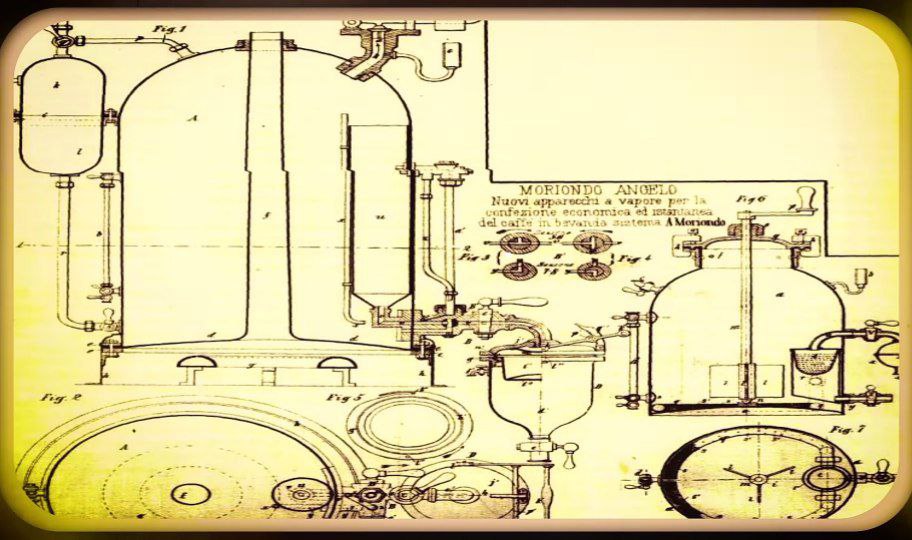.png)
Would life be possible without coffee, would our modern society cease to function if we could no longer drink our caffeine elixir?
So what is the history of coffee, sit back and relax, in this episode we will find out.
The history of coffee is fascinating. One related to Sufi Muslim mystics, French revolutionaries, slaves, soldiers.
Our story begins in a dark and frightening time in human history.
The ancient land of Ethiopia may be the cradle of all mankind, but more important than that, it is the cradle of coffee. There, in the mountainous jungles near Kaffa, coffee has grown for hundreds of years. We don't know exactly when humans started consuming coffee, but the most popular story has to do with some very happy goats.

One afternoon, an Ethiopian goat herder, named Kaldi, noticed that his goats were jumping around excitedly, some were even dancing, the goats were eating leaves and berries from a small bush, Kaldi, being curious, decided to eat some too, soon his heart was pounding, his mind was racing, and he was dancing with his goats, He had discovered the energetic properties of caffeine.
Now, this is just a story, Kaldi was probably not the first with a coffee addiction, the world's first coffee lovers were almost certainly the Oromo people, they had probably been chewing coffee beans and leaves for thousands of years, they would grind them up and mix them with fat to create ancient coffee energy bars.
Sometime in the mid-15th century, coffee sailed across the Red Sea with Oromo slaves to the port city of Mocha, which is now Yemen, where Sufi mystics discovered that the drink could keep them awake during their long night prayers. It was in Yemen that the consumption of coffee made from roasted beans was first documented. Here the most popular coffee species, Coffea arabica, was born, which now accounts for 60% of the world's coffee supply. They called the beverage Qahwa, the Arabic word for wine, which is probably where the word coffee comes from.
By the end of the 15th century, coffee had spread throughout the Islamic world and soon coffee houses were born, coffee houses found a niche in Islamic society, devout Muslims could not go to a bar, so coffee houses provided the Islamic world with a secular social space outside the home, where Muslim men could engage in lively conversations about politics, business and religion.
Coffee soon became so important that in Turkey, the inability to provide coffee beans, could be grounds for divorce, but some rulers thought that people enjoyed coffeehouses too much, their real concern was that people talked politics in coffeehouses and kept themselves informed, which usually did not please the rulers very much.
Coffee was banned in Mecca and Constantinople for a time during the 1500s and 1600s, but coffee drinking continued in secret until the bans were lifted.
While the Muslims drank in their elegant coffee houses, to the west of them stretched a small, divided and violent area called Europe.
Since coffee and tea had not yet reached Europe and drinking water was sometimes unsafe, beer was Europe's favorite beverage. A professor of medicine in 1551 stated that.
"people subsist more on this drink than on food".
On average, all men, women and children in England drank more than 350 liters of beer a year until the 17th century, while the Germans drank between 400 and 600 liters.
Europe staggered under this depressive and confusing alcoholic haze, until Dutch, Venetian and Italian merchants began to import coffee in the 17th century and then opened up a new and stimulating social space.
Curiously, it was first in England where the coffee culture captivated Europeans, the first coffee house in London opened in 1652, by 1700 there were more than 2,000 coffee houses called Universities for a Penny, because for the price of a cup of coffee you could sit and listen to the most intelligent people in the country talk, the bars were not the safest place to talk about politics or religion, people were drunk or armed, while the coffee houses provided a sober and caffeinated environment that encouraged debate and discussion.
That is why King Charles II tried to ban them in 1675, before being forced to retract, English coffeehouses fostered early capitalism, some of the largest companies in the world, such as Llyod's of London, The British East India Company and the London Stock Exchange, began as coffeehouses.
By 1777, coffee was so popular in Prussia that Frederick the Great complained:
"My people must drink beer. His Majesty was brought up on beer, as were his ancestors."
In 1781 he forbade his citizens to roast coffee, and created a secret police force, dubbed the
the coffee sniffers, who detected illegal coffee traders, but as elsewhere, the bans were soon repealed.
The Viennese were soon the next great coffee lovers in Europe, their great idea was to add sugar and milk to it, thus creating the Kapuziner, so called because it was the same color as the robes of the Capuchin monks, a drink that became famous with its Italian name, the cappuccino.
In 1669, a Turkish ambassador presented the coffee to Paris, and the French at first did not like the taste, but no matter how much they disliked the drink, it fascinated them as it made them feel, or in the words of Paludanus,
"to break wind and release any obstructions."
It got to a point that French doctors were prescribing coffee enemas.
Soon after its opening in 1689, the elegant Café Procope was already attracting the likes of Diderot, Rousseau, Voltaire and Benjamin Franklin. Soon, thousands of Parisian cafés were feeding the cultural and intellectual movement of the Enlightenment.
On July 12, 1789, Camille Desmoulins gave an impassioned speech standing on a café table and provoked an anti-aristocratic rage among the crowd, two days later they took the Bastille, starting the French Revolution.
In British North America, Washington, Hamilton and Jefferson used the coffee houses as venues for the American Revolution.

Europeans, now addicted to caffeine, were desperate to find supplies of coffee not controlled by the Ottoman Turks. In the mid-17th century, the Dutch took coffee out of India to grow in Ceylon, Java, Sumatra and throughout Southeast Asia. The Dutch colonists filled Europe with Asian coffee grown by enslaved natives.
In 1860, the Dutch civil servant Eduard Douwes Dekker resigned in horror and wrote the novel "Max Havelaar", which documented the terror that took place in Java and attacked the Dutch landowners who "enriched themselves with the poverty of others".
In 1720 the Frenchman Gabriel Mathieu de Clieu took a coffee plant to the colony of Martinque, it was a harrowing journey where his ship was attacked by pirates, storms and dehydration, during the voyage he shared his daily ration of half a cup of water with the tiny coffee plant, but his sacrifice paid off, 50 years later there were 18 million coffee plants on the island, The offspring of his plant is now responsible for a large part of the world's coffee supply.
William Ukers wrote of coffee:
"Wherever it has been introduced, it has meant a revolution. It has been the most radical drink in the world because its function has always been to make people think. And when people begin to think, it becomes dangerous to tyrants."
The irony was that while coffee was seen as helping to liberate Europe and the United States from tyrants, it brought tyranny elsewhere.
De Clieu almost sacrificed his life for his coffee plant. But he never thought of harvesting it himself, the slaves in Africa would do that.
In 1780, 60% of all coffee consumed in Europe came from the small French colony of Saint-Domingue, harvested by more than 500,000 African slaves.
So the coffee that inspired Voltaire and the Enlightenment used the most terrible form of forced labor.
JHB De Saint Pierre, noted while traveling in the Caribbean in 1773.
"I do not know whether coffee and sugar are essential to the happiness of Europe ... but I know well that these two products have represented the unhappiness of two great regions of the world: America has been depopulated to have land to plant them on; and Africa has been depopulated for people to cultivate them".
The French Revolution of 1789 inspired the slaves of Saint-Domingue to revolt and demand their own freedom, thus creating the slave-free nation of Haiti in 1804.
.jfif)
However, when it comes to the number of slaves, Brazil takes the prize. In the first half of the 19th century alone, 1.5 million African slaves were sent to work on the coffee plantations, known as latifundios. This made the coffee men some of the richest in Brazil. This led Brazil to maintain slavery longer than any other nation in the western hemisphere, banning it only in 1888.
Brazil conquered the world of coffee, producing such an extraordinary amount that it helped increase demand by making coffee cheap enough for members of the working classes in North America and Europe, Brazil democratized coffee but did so at the cost of slavery.
In the 1920s, Brazil produced 80% of the world's coffee, has been the leading coffee producer for 150 years and in 2017 produced over 2.5 million tons, that's 1/3 of the global supply.
Coffee created modern Brazil, but at a huge cost, according to Eduardo Galeano, Brazil was.
Quickly annihilated by this perishable plant that, cultivated in a destructive system, was leaving behind it devastated forests, depleted natural reserves and general decadence".
At the same time that Brazil led the coffee boom, Central America also came to depend on the same trees. The history of Guatemala is an example of what also occurred throughout the region.
After gaining independence from Spain, the government turned to coffee cultivation as a potential source of wealth, however, the main coffee lands were occupied by indigenous peoples such as the Mayans, this land was confiscated by wealthy coffee planters, and the indigenous peoples were forced to work on the massive new coffee plantations, they were guarded by a huge army, Jeffrey Paige wrote in Coffee and Power,
"Guatemala had so many soldiers that it looked like a penal colony, because it was a penal colony based on forced labor."
This system dominated Central America, the only local exception being Costa Rica, most of Costa Rica's indigenous peoples had been wiped out centuries earlier by Spanish settlers and disease.
When Costa Ricans began growing coffee in the 1830s, they could not manage large slave plantations like Brazil and Guatemala, they still enslaved some, but there simply were not many. So, small farming families, working together, did the physical labor. By not relying on slave labor, Costa Rica was able to become a more united and stable nation.
In 1906, while in Guatemala, George Washington, while in Guatemala, mixed refined coffee crystals with water to prepare instant coffee, he was not the first to invent instant coffee, but he was the first to mass produce it. His invention arrived just in time for World War I and the massive demand for instant coffees.
In 1918, the U.S. Army bought all of George Washington's instant coffee production. By the time the war ended, the U.S. Army was brewing more than 40 million cups of coffee a day.
Back to Asia, in 1869 an outbreak of coffee leaf rust caused by the fungus Hemileia vastatrix first appeared in Ceylon, which was controlled by the British, and wiped out all their Coffea Arabica plants along with those of India, Java, Sumatra and the rest of Southeast Asia. Many switched to tea cultivation and turned Britain into a tea fanatic nation.
This started a panic search for other coffee species, and along came Coffea canephora, better known as Robusta, native to Central Africa and discovered just as the fungus ruined the Asian crops.
It turned out to be resistant to diseases, having twice the caffeine content of Arabica and could grow essentially anywhere in the coffee belt. Its only disadvantage was its taste, being more bitter and with hints of nuts, wood and straw, which had to be mixed with some Arabica to improve its flavor and make it more drinkable.
In 1938, Nestlé launched Nescafé, a new and improved instant coffee powder that invaded the world instant coffee market, and the taste was so bad that it did not matter if cheap Robusta beans were used, which led to a boom in the cheap instant coffee industry in the post World War II period.
Today, Robusta accounts for 40% of world coffee production.
Competing with instant coffee were the Italians.

In 1884, Angelo Moriondo invented the first espresso machine, which was later improved in 1901 by Luigi Bezzera.
This new "Espresso" was made by forcing almost boiling water at high pressure through very fine beans, before this, coffee took up to five minutes to brew, espresso reduced this to thirty seconds and also produced a more consistent cup of coffee.
By 1930, espresso was already in cafés all over Europe and the United States, the speed of espresso made it the ideal drink to have before work and during the recently invented coffee breaks, it became the perfect drug to boost capitalism.
Now much of the world orders its coffee in Italian, espresso, cappuccino, latte, macchiato, even Americano, a drink invented for American soldiers, is ordered in Italian, all thanks to the espresso revolution in Italy.
The espresso revolution soon moved into the home and spurred the creation of dozens of appliances to prepare espresso.
Within the coffee industry until now, all the focus had been on creating the perfect or cheapest cup, but the beans that produced people's cappuccinos were harvested by hungry farmers.
So Fairtrade International began in 1997 to try to ensure a certain fair standard for products like coffee. To be labeled Fairtrade, the production chain must follow Fairtrade standards on workers', environmental and children's rights, along with paying the Fairtrade Minimum Price.
Sales of Fairtrade coffee have skyrocketed since its launch, but it has also had its fair share of critics, it is not a perfect system, but it has done a lot to improve some lives and working conditions.
Caffeine is now the world's most popular drug and coffee is its most popular agent, currently brewing around 1.4 billion cups of coffee a day. From a mystical Muslim drink, to a colonial commodity, to a revolutionary beverage and fuel for capitalism, this small African bean has transformed our world.
Coffee is one of the many foods that changed the history of humanity.
Source of plagiarism
Plagiarism is the copying & pasting of others' work without giving credit to the original author or artist. Plagiarized posts are considered fraud and violate the intellectual property rights of the original creator.
Fraud is discouraged by the community and may result in the account being Blacklisted.